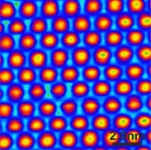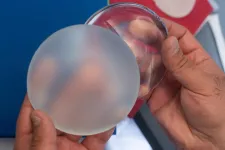(Press-News.org) A research team led by the University of Arizona has reconstructed in unprecedented detail the history of a dust grain that formed during the birth of the solar system more than 4.5 billion years ago. The findings provide insights into the fundamental processes underlying the formation of planetary systems, many of which are still shrouded in mystery.
For the study, the team developed a new type of framework, which combines quantum mechanics and thermodynamics, to simulate the conditions to which the grain was exposed during its formation, when the solar system was a swirling disk of gas and dust known as a protoplanetary disk or solar nebula. Comparing the predictions from the model to an extremely detailed analysis of the sample's chemical makeup and crystal structure, along with a model of how matter was transported in the solar nebula, revealed clues about the grain's journey and the environmental conditions that shaped it along the way.
The grain analyzed in the study is one of several inclusions, known as calcium-aluminum rich inclusions, or CAIs, discovered in a sample from the Allende meteorite, which fell over the Mexican state of Chihuahua in 1969. CAIs are of special interest because they are thought to be among the first solids that formed in the solar system more than 4.5 billion years ago.
Similar to how stamps in a passport tell a story about a traveler's journey and stops along the way, the samples' micro- and atomic-scale structures unlock a record of their formation histories, which were controlled by the collective environments to which they were exposed.
"As far as we know, our paper is the first to tell an origin story that offers clues about the likely processes that happened at the scale of astronomical distances with what we see in our sample at the scale of atomic distances," said Tom Zega, a professor in the University of Arizona's Lunar and Planetary Laboratory and the first author of the paper, published in The Planetary Science Journal.
Zega and his team analyzed the composition of the inclusions embedded in the meteorite using cutting-edge atomic-resolution scanning transmission electron microscopes - one at UArizona's Kuiper Materials Imaging and Characterization Facility, and its sister microscope located at the Hitachi factory in Hitachinaka, Japan.
The inclusions were found to consist mainly of types of minerals known as spinel and perovskite, which also occur in rocks on Earth and are being studied as candidate materials for applications such as microelectronics and photovoltaics.
Similar kinds of solids occur in other types of meteorites known as carbonaceous chondrites, which are particularly interesting to planetary scientists as they are known to be leftovers from the formation of the solar system and contain organic molecules, including those that may have provided the raw materials for life.
Precisely analyzing the spatial arrangement of atoms allowed the team to study the makeup of the underlying crystal structures in great detail. To the team's surprise, some of the results were at odds with current theories on the physical processes thought to be active inside protoplanetary disks, prompting them to dig deeper.
"Our challenge is that we don't know what chemical pathways led to the origins of these inclusions," Zega said. "Nature is our lab beaker, and that experiment took place billions of years before we existed, in a completely alien environment."
Zega said the team set out to "reverse-engineer" the makeup of the extraterrestrial samples by designing new models that simulated complex chemical processes, which the samples would be subjected to inside a protoplanetary disk.
"Such models require an intimate convergence of expertise spanning the fields of planetary science, materials science, mineral science and microscopy, which was what we set out to do," added Krishna Muralidharan, a study co-author and an associate professor in the UArizona's Department of Materials Science and Engineering.
Based on the data the authors were able to tease from their samples, they concluded that the particle formed in a region of the protoplanetary disk not far from where Earth is now, then made a journey closer to the sun, where it was progressively hotter, only to later reverse course and wash up in cooler parts farther from the young sun. Eventually, it was incorporated into an asteroid, which later broke apart into pieces. Some of those pieces were captured by Earth's gravity and fell as meteorites.
The samples for this study were taken from the inside of a meteorite and are considered primitive - in other words, unaffected by environmental influences. Such primitive material is believed to not have undergone any significant changes since it first formed more than 4.5 billion years ago, which is rare. Whether similar objects occur in asteroid Bennu, samples of which will be returned to Earth by the UArizona-led OSIRIS-REx mission in 2023, remains to be seen. Until then, scientists rely on samples that fall to Earth via meteorites.
"This material is our only record of what happened 4.567 billion years ago in the solar nebula," said Venkat Manga, a co-author of the paper and an assistant research professor in the UArizona Department of Materials Science and Engineering. "Being able to look at the microstructure of our sample at different scales, down to the length of individual atoms, is like opening a book."
The authors said that studies like this one could bring planetary scientists a step closer to "a grand model of planet formation" - a detailed understanding of the material moving around the disk, what it is composed of, and how it gives rise to the sun and the planets.
Powerful radio telescopes like the Atacama Large Millimeter/submillimeter Array, or ALMA, in Chile now allow astronomers to see stellar systems as they evolve, Zega said.
"Perhaps at some point we can peer into evolving disks, and then we can really compare our data between disciplines and begin answering some of those really big questions," Zega said. "Are these dust particles forming where we think they did in our own solar system? Are they common to all stellar systems? Should we expect the pattern we see in our solar system - rocky planets close to the central star and gas giants farther out - in all systems?
"It's a really interesting time to be a scientist when these fields are evolving so rapidly," he added. "And it's awesome to be at an institution where researchers can form transdisciplinary collaborations among leading astronomy, planetary and materials science departments at the same university."
INFORMATION:
The study was co-authored by Fred Ciesla at the University of Chicago and Keitaro Watanabe and Hiromi Inada, both with the Nano-Technology Solution Business Group at Hitachi High-Technologies Corp. in Japan.
Funding was provided through NASA's Emerging Worlds Program; NASA's Origins Program; and NASA's Nexus for Exoplanet System Science (NExSS) research coordination network, which is sponsored by NASA's Science Mission Directorate. NASA and the National Science Foundation provided the funding for the instrumentation in LPL's Kuiper Materials Imaging and Characterization Facility.
The USC Stem Cell laboratory of Andy McMahon has identified a type of injured cell that might contribute to the transition from an acute kidney injury to chronic kidney disease, as described in a new study published in the Proceedings of the National Academy of Sciences (PNAS). The same issue of PNAS also features an accompanying Q&A with McMahon to mark his recent election as a member of the National Academy of Sciences.
"Acute kidney injury can be a common side effect of surgery, sepsis or certain prescription drugs, and there is no effective treatment," said McMahon, who is the W.M. Keck Provost and University Professor of Stem Cell Biology and Regenerative Medicine, and Biological Sciences at USC. "Even a mild or moderate injury can progress into chronic ...
CAMBRIDGE, Mass. - Women who lose local or state elections are just as likely to run for office again as men, suggesting the recent surge in women running for office may have a long-term impact on women's political representation, according to a new study by researchers from Harvard and the University of California, Davis.
Pundits and scholars have argued that women are more likely to abandon politics after a losing campaign than men, citing evidence that women are more risk-averse and more likely to avoid competition than men.
Political scientists Rachel Bernhard, assistant professor at UC-Davis, and Justin de Benedictis-Kessner, assistant professor of public policy at Harvard Kennedy School, ...
Team used Argonne's GREET model to simulate changes, predict outcomes.
Scientists from the U.S. Department of Energy's Argonne National Laboratory participated in a study that shows innovation in technologies and agricultural practices could reduce greenhouse gas (GHG) emissions from grain production by up to 70% within the next 15 years.
Published in Proceedings of the National Academy of Sciences of the United States, the study identifies a combination of readily adoptable technological innovations that can significantly reduce emissions and fit within current production systems and established grain markets.
The study, "Novel ...
A species of butterfly found in Sub-Saharan Africa is able to migrate thousands of miles to Europe, crossing the Saharan Desert, in years when weather conditions are favourable, scientists have found.
The striking Painted Lady (Vanessa cardui) butterfly has been shown for the first time to be capable of making the 12,000-14,000km round trip - the longest insect migration known so far - in greater numbers, when wetter conditions in the desert help the plants on which it lays eggs.
The international research team's findings increase understanding of how insects, including pollinators, pests and the diseases they carry could spread between continents in ...
Lead levels in London's atmosphere have dropped drastically since lead additives in petrol were phased out, and currently meet UK air quality targets. However despite this drop, airborne particles in London are still highly lead-enriched compared to natural background levels, according to new Imperial research published today in PNAS.
The study found that up to 40 per cent of lead in airborne particles today comes from the legacy of leaded petrol. The researchers say this highlights the long-term persistence of contaminants introduced by human activities in the environment.
Lead author of the study Dr Eléonore Resongles, who carried out the work at Imperial's Department of Earth Science and Engineering, said: "Petrol-derived lead deposited decades ago remains an important ...
One vision that is currently driving material scientists is to combine organic molecules (and their diverse functionalities) with the technological possibilities offered by extremely sophisticated semiconductor electronics. Thanks to modern methods of micro- and nanotechnology, the latter designs ever more efficient electronic components for a wide variety of applications. However, it is also increasingly reaching its physical limits: Ever smaller structures for functionalizing semiconductor materials such as silicon cannot be produced using the approaches of classical technology. Scientists ...
Think about how many different pieces of technology the average household has purchased in the last decade. Phones, TVs, computers, tablets, and game consoles don't last forever, and repairing them is difficult and often as expensive as simply buying a replacement.
Electronics are integral to modern society, but electronic waste (e-waste) presents a complex and growing challenge in the path toward a circular economy--a more sustainable economic system that focuses on recycling materials and minimizing waste. Adding to the global waste challenge is the prevalence of dishonest recycling practices by companies who claim to be recycling electronics but actually dispose of them by other means, such as in ...
BEER-SHEVA, Israel, June 21, 2021 - A team of scientists at Ben-Gurion University of the Negev (BGU) have invented an artificial nose that is capable of continuous bacterial monitoring, which has never been previously achieved and could be useful in multiple medical, environmental and food applications.
The study was published in Nano-Micro Letters.
"We invented an artificial nose based on unique carbon nanoparticles ("carbon dots") capable of sensing gas molecules and detecting bacteria through the volatile metabolites the emit into the air," says lead researcher Prof. Raz Jelinek, BGU vice president ...
In recent years, many juvenile courts have adopted in-home detention with electronic monitoring tethers as an alternative to institutional incarceration. A new study examined whether this approach reduces recidivism among girls involved in the juvenile justice system. The study found that tethers failed to reduce reoffending among the girls; in fact, they may be harmful because in-home detention limits girls' access to treatment programs.
The study, by researchers at the University of Cincinnati (UC) and Michigan State University, appears in Justice Evaluation Journal, a publication of the Academy of Criminal Justice Sciences.
"We believe this ...
HOUSTON - (June 21, 2021) - Rice University bioengineers collaborated on a six-year study that systematically analyzed how the surface architecture of breast implants influences the development of adverse effects, including an unusual type of lymphoma.
Every year, about 400,000 people receive silicone breast implants in the United States. According to FDA data, most of those implants need to be replaced within 10 years due to the buildup of scar tissue and other complications.
A team including researchers from the Massachusetts Institute of Technology (MIT), Rice, the University of Texas MD Anderson Cancer Center and Baylor College of Medicine published its findings online ...




